|
Combat Skills of
the Soldier
FM 21-75
HEADQUARTERS
DEPARTMENT OF THE ARMY
Washington, DC,
3 August 1984
APPENDIX A
Mines
A unit may use mines during security, defensive, retrograde, and offensive
operations in order to reduce the enemy's mobility. In those operations, leaders
pick the places for the mines and their men emplace them and, when required,
retrieve them (See TM 9--1345-203-12P).
The mines you will most commonly use are:
-
M14, Antipersonnel
-
M16A1, Antipersonnel
-
M18A1, Antipersonnel
-
M26, Antipersonnel
-
M15, Antitank
-
M21, Antitank
-
M24, Off-Route Antitank
ANTIPERSONNEL
M14, ANTIPERSONNEL MINE
This is a blast-type, high-explosive mine with a plastic body. A pressure of
9 to 15.8 kg (20 to 35 lb) will detonate it.
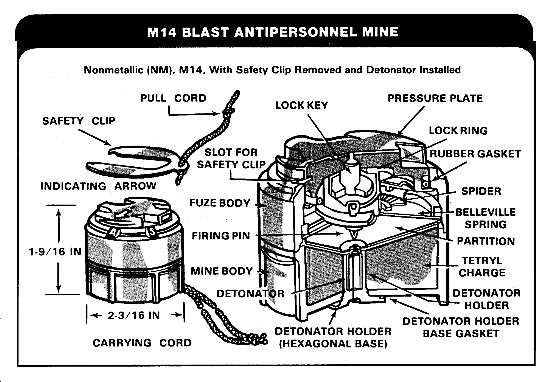
To emplace an M14 mine:
-
Remove the mine from the packing box and inspect it. If the mine is
cracked or otherwise damaged, do not use it.
-
Use the M22 wrench from the packing box to unscrew the white plastic
shipping plug from the detonator well in the bottom of the mine. Keep the
shipping plug for possible future use.
-
Inspect the firing pin's position. If it extends into the detonator well.
the mine is unsafe to use.
-
Inspect the detonator well for foreign matter. If foreign matter is
present, carefully remove it by tapping the mine against the palm of the hand.
-
Dig a hole about 10 cm (4 in) in diameter and just deep enough (about 3.8
em [1.5 in]) so that the pressure plate of the mine will extend above the
ground.
-
Make sure the ground at the bottom of the hole is solid enough to support
the mine when pressure is applied to the pressure plate. If the ground is too
soft, place a block of wood or other solid support in the bottom of the
hole.
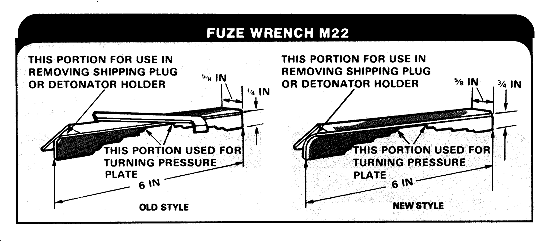
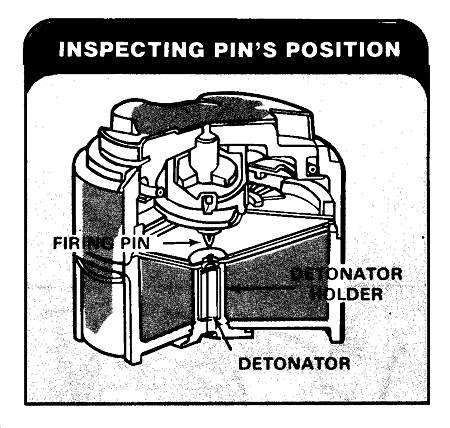


To disarm and remove an M14 mine, reverse the steps used to arm and emplace
it.
-
Inspect the area around the mine to see if the mine has been tampered
with. If it has been, do not try to disarm it. Report the tampering to your
leader.
-
Remove the soil from the mine without putting pressure on the mine.
-
Grasp the body of the mine with one hand and insert the safety clip with
the other.
-
With the safety clip in place, turn the pressure plate so that the arrow
points to S (SAFE). That disarms the mine.
-
Remove the mine from the hole.
-
Turn the mine over and carefully remove the detonator from the detonator
well.
-
Screw the plastic shipping plug into the detonator well.
-
Clean off the mine and put it in a packing box.
M16A1, ANTIPERSONNEL MINE
This is a bounding, fragmentation mine with a metallic body. It can be set
for pressure detonation or set with a tripwire attached to a release-pin ring. A
pressure of 3.6 kg (8 lb) or more against one or more of the three prongs of the
fuze, or a pull of 1.3 kg (3 lb) or more on the tripwire, will detonate the
mine.
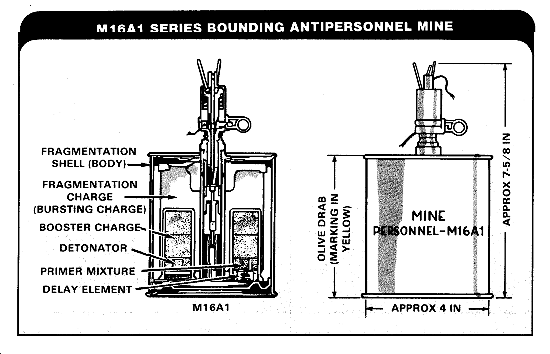
To emplace an M16A1 mine:
-
Remove the mine from its packing box and inspect it for damage. If the
mine is dented, cracked, or otherwise damaged, do not use it.
-
Unscrew the shipping plug from the fuze well with the closed end of the
M25 fuze wrench. Keep the shipping plug for future disarming of the mine, if
required.
-
Inspect the fuse well and flash tube of the mine for foreign matter. If
foreign matter is present, turn the mine upside down and gently tap its bottom
to dislodge the matter.
-
Set the mine down and take a fuze out of the fuze box.
-
Inspect the fuze for damage and for missing safety pins. Make sure that
the safety pins move freely in the safety-pin holes. Also make sure that the
rubber gasket is around the fuse base.
-
With the open end of the wrench, make sure that the bushing adapter on the
fuze well is tight.
-
Screw the fuze assembly into the fuze well with the fuze wrench.
-
Dig a hold about 15 cm (6 in) deep and 13 cm (5 in) in diameter.
-
Put the mine in the hole.
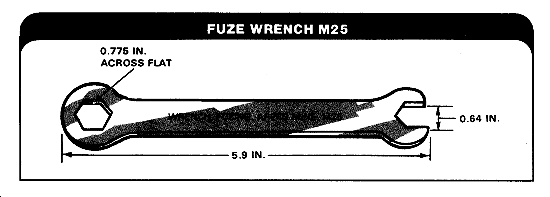
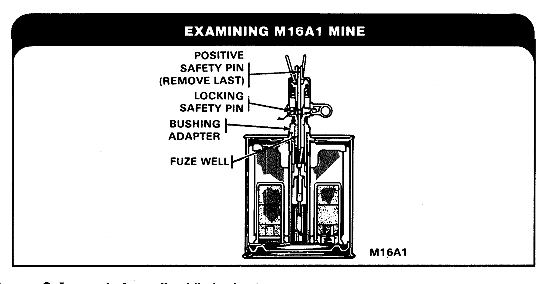
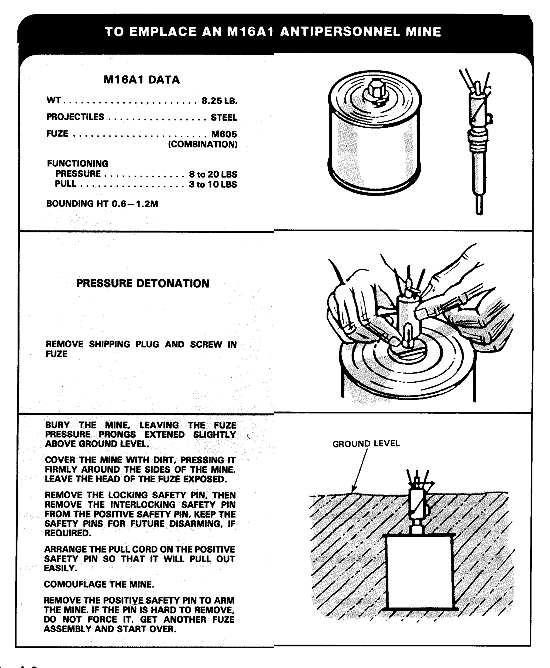
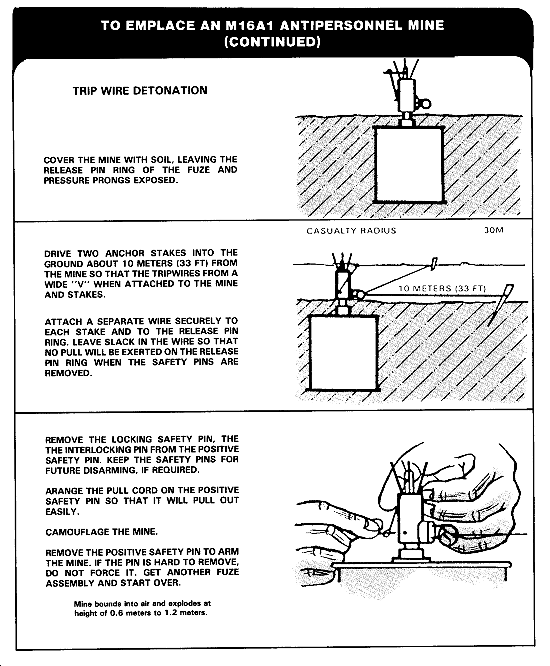
To disarm and remove an M16A1 mine, reverse the steps used to arm and emplace
it.
-
Check the mine and the area around it to see if the mine has been tampered
with.
-
If it has been, do not try to disarm it.
-
Report the tampering to your leader.
-
Uncover the top of the mine.
-
Insert the positive safety pin through the positive safety pin hole.
-
Insert the locking safety pin through the locking safety pin hole opposite
the release-pin ring.
-
Insert the interlocking safety pin between the positive safety pin and
locking safety pin.
-
If tripwires are attached to the release-pin ring, cut all of them after
the safety pins have been inserted.
-
Remove the dirt from around the mine and then lift the mine out of the
hole.
-
Unscrew and remove the fuze assembly.
-
Replace the plastic shipping plug in the fuze well.
-
Replace the mine and fuze in the packing box.
M18A1, ANTIPERSONNEL MINE (CLAYMORE)
This is a curved, rectangular mine containing C4 explosive and 700 steel
balls. It can be fired electrically or nonelectrically.
The Claymore projects 700 steel balls in a fan-shaped pattern about 2 meters
(6.6 ft) high and 60 degrees wide to a range of 50 meters (165 ft). These balls
are effective as far as 100 meters (328 ft) and are dangerous up to 250 meters
(825 ft) forward of the mine.

To emplace a Claymore for command detonation:
-
Remove the electrical firing wire, the firing device, and test set from
the bandoleer. Do not take the mine out of the bandoleer.
-
Position the firing-device safety bail in the FIRE position and squeeze
the firing-device handle with a firm, quick squeeze.

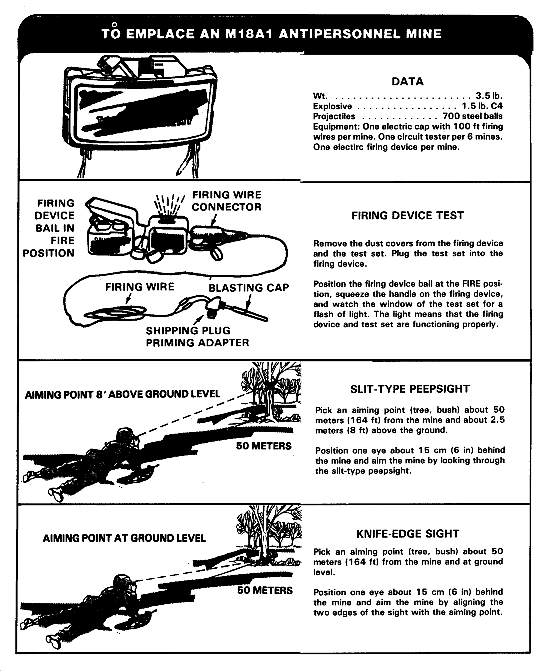
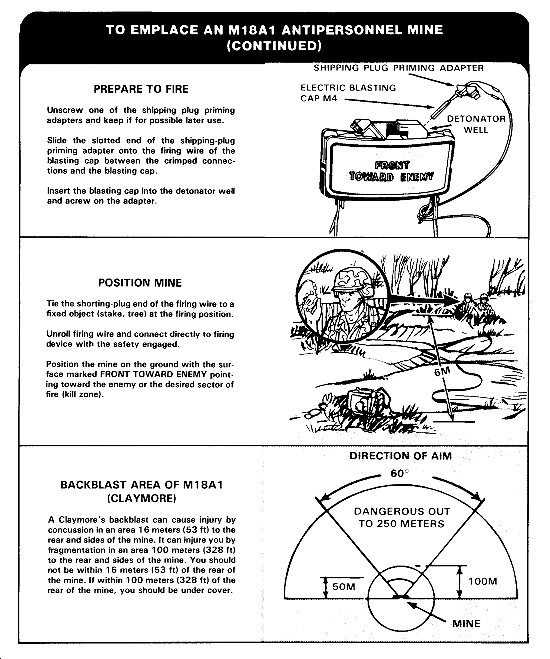
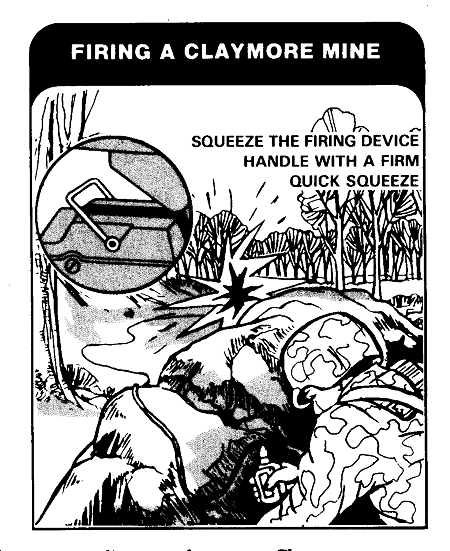
To disarm and remove a Claymore, reverse arming and emplacing procedure.
-
Make sure that the firing-device safety bail is in the SAFE position.
-
Disconnect the firing wire from the firing device and replace the dust
covers.
-
Move to the mine and unscrew and remove the shipping-plug priming adapter
from it. Take the firing device with you.
-
Remove the blasting cap from the shipping-plug priming adapter and then
screw the adapter back into the detonator well.
-
Put the blasting cap inside its cardboard container, remove the firing
wire from the stake, and reroll the firing wire.
-
Pick up the mine and put it in the bandoleer.
-
Remove the firing wire from the stake at the firing position and put it in
the bandoleer.
To emplace a Claymore with a tripwire:
-
Emplace and aim the mine to cover the desired kill zone.
-
Put an anchor stake (1) about 1 meter (3.3 ft) to the rear of the mine and
attach the firing wire to it, leaving about 1.5 meters (5 ft) of slack. Do not
insert the blasting cap into the mine at this time.
-
Unroll the firing wire to a point about 20 meters (66 ft) to either the
left or right front of the mine. Put an anchor stake (2) at that point.
-
Attach a clothespin (or other improvised device) to stake (2) with its
closed end pointing toward the kill zone. The clothespin can be tied or nailed
to the stake.
-
Move across the kill zone and put in another stake (3).
-
Attach the trip wire to stake (3) and unroll the tripwire to stake (2).
-
Attach the end of the tripwire to a C-ration plastic spoon or some other
nonconductor of electricity. Connect the tripwire and spoon before setting up
the mine.
-
Prepare the firing wire at stake (2) for connection to the clothespin by
cut- ting one strand of the firing wire and forming two bare wire loops that
can fit over the ends of the clothespin. (Do that before setting up the mine.)
-
Slide the loops over the ends of the clothespin and tighten them to fit in
the grooves of the clothespin.
-
Insert the tripwire spoon into the jaws of the clothespin. The tripwire
should be about ankle-high and not too tight.
-
Unroll the firing wire to a site to the rear of the mine and put in
another anchor stake (4).
-
Attach the firing wire to stake (4).
-
Move to the mine, insert the blasting cap into the detonating well, screw
in the shipping-plug priming adapter, and recheck the aim.
-
Move to stake (4) to attach the firing wire to the power source.
-
Cut the shorting plug and dust cover from the end of the firing wire and
remove about 2.54 cm (1 in) of insulation from each strand of the firing wire.
-
Twist the ends of the wires and attach them to a power source (BA 206 or
BA 4386 battery or any other power source that produces at least 2 volts of
electricity). The system is now ready.
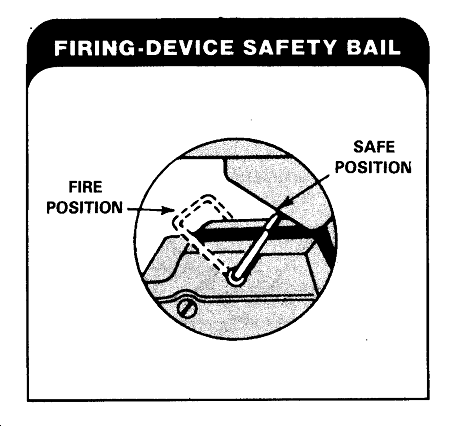
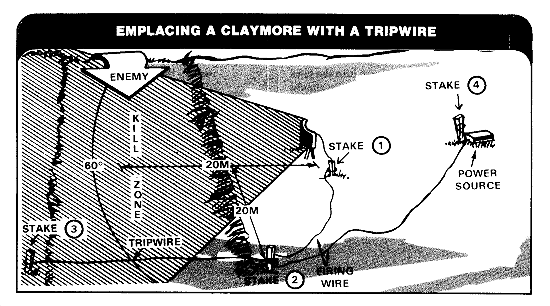

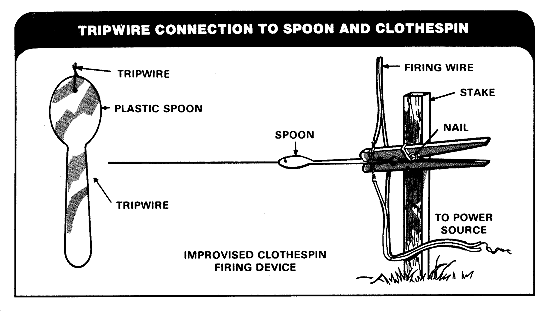
To disarm and remove a Claymore with a tripwire, reverse the steps used -to
arm and install it.
-
Disconnect the firing wire from the power.
-
Remove the blasting cap from the mine and place the cap in its protective
cover.
-
Place the mine in the bandoleer.
-
Roll up the firing wire and recover the other items, going from stake (1)
to (2), (2) to (3), and (3) to (4).
-
Put all of the accessories in the bandoleer and move back to your
position.
M26, ANTIPERSONNEL MINE
This is a small, bounding, fragmentation mine. It can be set for either
pressure or trip-wire activation. A pressure of 13 kg (28 lb) on top of the
mine, or a pull against the tripwire will detonate it.

To emplace an M26 mine for pressure detonation:
-
Dig a hole in the ground about 13 cm (5 in) deep and wide enough to accept
the mine.
-
Remove a 2.5 cm (1 in) layer of dirt out to about 15 cm (6 in) from around
the mine to allow knuckle clearance needed when turning the arming handle.
|
NOTE: Leave the tripwire spool assembly attached to the mine This helps
to stabilize the mine in the hole. |
-
Remove the arming handle from the tripwire spool by pulling it upward from
the spool.
-
Close the spread ends of the arming-latch retaining pin (cotter pin) to
aid its removal after the mine is emplaced.
-
Place the mine in the hole, with cover end up, so that the mine cover lugs
extend just slightly above ground level.
-
Pack the dirt around the mine, leaving the cover lugs exposed.
-
Remove the arming-latch retaining pin by pulling the ring straight up.
-
Attach the arming handle to the lugs on the arming latch. Hold the mine
firmly with the thumb and finger of one hand to keep it from turning. Turn the
cover clockwise (about 1/4 turn) until it stops.
-
The arrow on the mine cover should be slightly past the center of the red
A (armed) position.
-
Camouflage the mine.
-
Remove the arming latch from the mine by pulling straight out on the
arming handle. Keep the arming latch and arming handle for future use. The
mine is now armed.


To disarm and remove an M26 mine set for pressure detonation, reverse the
steps used to arm and install the mine.
-
Carefully remove all camouflage from around the top of the mine.
-
If there is any sign of boobytrapping or tampering, do not try to disarm
and remove the mine. Instead, destroy the mine in place.
-
If there are no signs of boobytrapping or tampering, replace the arming
latch by sliding it under the arming handle lugs from the side opposite the
arrow.
-
Make sure that the middle prong of the arming latch engages the trip-lever
cam.
-
Remove a 2.5 cm (1 in) layer of dirt out to about 15 cm (6 in) from the
edge of the mine to allow knuckle clearance.
-
Attach the arming handle to the arming latch.
-
Hold the mine with one hand and turn the cover counterclockwise with your
other hand until it stops (about 1/4 turn).
-
The arrow on the cover should line up with the S (SAFE) position on the
mine.
-
Remove the arming handle.
-
Insert the arming-latch retaining pin through the holes in the arming
latch and mine body. (It may be necessary to rotate the latch back about 1/2
cm [1/4 in] to align the holes.)
-
Remove the mine from the hole.
-
Clear the mine and repackage it.
To emplace an M26 mine for tripwire detonation:
-
Dig a hole in the ground about 13 cm (5 in) deep and wide enough for the
mine.
-
Remove a 2.5 cm (1 in) layer of dirt out to about 15 cm (6 in) from around
the mine to allow knuckle clearance needed when turning the arming handle.
-
Remove the tripwire spool assembly by pulling it away from the mine body.
-
Remove the arming handle from the tripwire spool by pulling it upward.
-
Unscrew and remove the trip lever from the tripwire spool.
-
Remove one or more tripwires, as required, from the tripwire spool by
pressing in on the plastic tripwire retainer(s) and lifting the tripwire(s)
off the top of the spool.
-
Retain or replace any unused tripwires on the spool.
-
Replace the tripwire spool assembly on the mine. Leave the spool on the
mine to help stabilize it.
-
Close the spread ends of arming-latch retaining pin (cotter pin) to aid
its removal after the mine is emplaced.
-
Place the mine in the hole with the cover end up, so that the mine cover
lugs extend just slightly above ground level.
-
Pack the dirt around the mine, leaving the cover lugs exposed.
-
Screw the trip lever about four turns into the trip-lever cam (in the top
center of the mine cover) until it is tight.
-
Cut the tape holding the coils of wire.
-
Attach the loop end(s) of the tripwire(s) to the loop of the trip lever.
-
Leaving some slack, attach the other end of the tripwire(s) to a firm
anchor stake(s).
-
Remove the arming-latch retaining pin by pulling the ring straight up.
-
Assemble the arming handle to the lugs on the arming latch. Hold the mine
body firmly with your thumb and finger of one hand to keep the mine from
turning. Rotate the cover clockwise (from S to A) until it stops (about 1/4
turn).
-
Camouflage the mine.
-
Remove the arming latch from the mine by pulling straight out on the
arming handle. Keep the arming latch and arming handle for future use. The
mine is now armed.
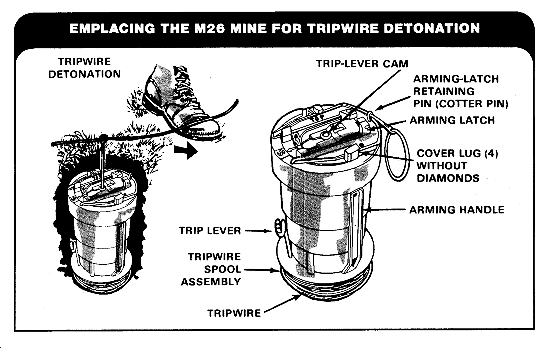
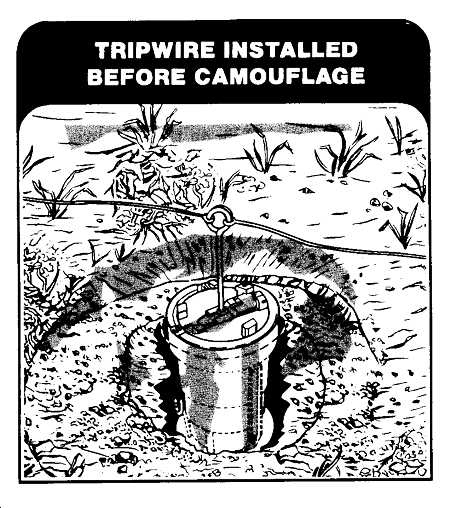
To disarm and remove an M26 mine emplaced for tripwire detonation, reverse
the steps used to arm and install the tripwire detonation.
-
Carefully remove all camouflage from around the mine.
-
If there is any evidence of boobytrapping or tampering, do not try to
disarm and remove the mine. Take care not to move the trip lever or press on
the mine cover.
-
Replace the arming latch. With the two raised arming handle lugs facing
upward, slide the arming latch under the six lugs of the mine cover from the
side opposite the arrow. Make sure that the middle prong of the arming latch
engages the trip-lever cam.
-
Remove a layer of dirt about 2.5 cm (1 in) deep for a distance of about 15
cm (6 in) from the edge of the mine to allow knuckle clearance for turning and
removing the arming latch.
-
Attach the arming handle to the lugs on the arming latch.
-
Hold the mine with one hand and turn the mine cover counterclockwise with
your other hand until it stops (about ¼ turn). The arrow on the cover should
point to the S (SAFE) position on the mine body.
-
Remove the arming handle from the mine and keep it for future use.
-
Insert the arming-latch retaining pin through the holes in the arming
latch and mine body. It may be necessary to turn the latch back (up to ½ cm [¼
in]) to align the holes of the latch and body.
-
Remove the mine from the ground. Clean the mine and repackage it.
ANTITANK
M15, ANTITANK MINE
This antitank mine has a cylindrical steel body. It is pressure detonated. A
force of 159 to 340 kg (350 to 750 lb) on the pressure plate will detonate the
mine.
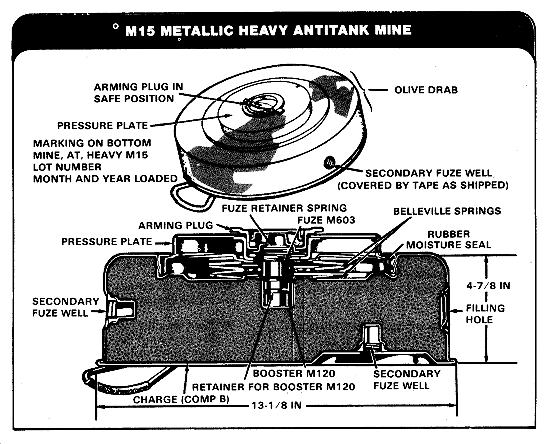
To emplace an M15 mine:
-
Remove the mine from its packing box.
-
Using the M20 wrench, unscrew the arming plug by turning it
counterclockwise. Take it out of the mine.
-
Inspect the fuze well for foreign matter. Remove any found.
-
Make sure that the booster retainer is seated in the fuze well. If it is
missing, replace the mine.
-
Put the mine down and pick up the metal fuze container.
-
Open the container with the key attached to its bottom.
-
Remove the fuze from the container.
-
Make sure that the green end of the detonator shows in the bottom of the
fuze and that the safety clip is in place between the pressure plate and the
body of the fuze.
-
Remove the safety fork from between the pressure plate and the body of the
fuze. Keep the safety fork for future use.
-
Insert the fuze into the fuze well. Make sure that the fuze is seated
securely on top of the booster retainer. Put no-pressure on the pressure plate
when handling the fuze.
-
Check the clearance of the pressure plate of the fuze in the fuze well by
using the tab end of the M20 wrench. If the pressure plate is too high, the
button on the plate will interfere with the movement of the arming shutter in
arming the mine. If the fuze does not fully seat, remove it and replace it
with another fuze.
-
Pick up the arming plug M4 and turn the setting knob to the SAFE
position--if it is not already on SAFE.
-
Dig a hole about 38 cm (15 in) in diameter and 15 cm (16 in) deep, with
walls sloping 45 degrees.
-
Check the bottom of the hole to make sure that the ground is solid so that
the mine will not sink into the ground. If it is not solid, insert a wooden
board or other support to give the mine a firm foundation.
-
Lay the mine in the hole so that the top surface of the pressure plate is
about 3 cm (1½ in) below ground level.
-
Fill in the dirt around the mine and pat it down.
-
Using the M20 wrench, arm the mine by turning the setting knob from SAFE
through DANGER to ARMED.
-
Camouflage the mine.
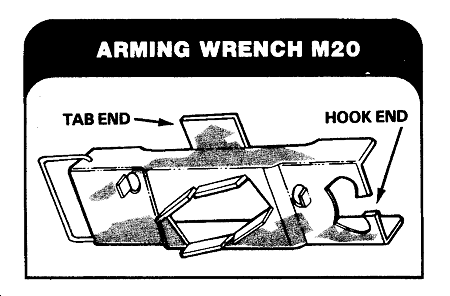
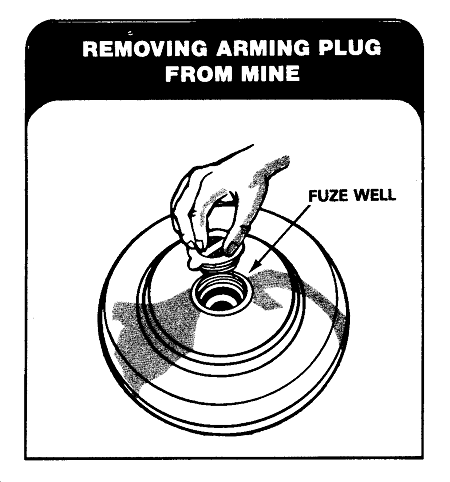


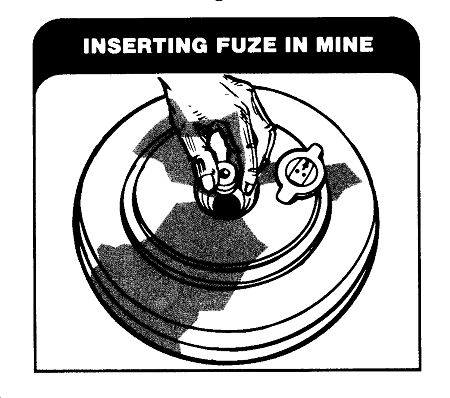

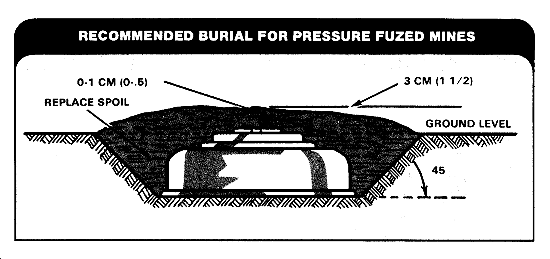
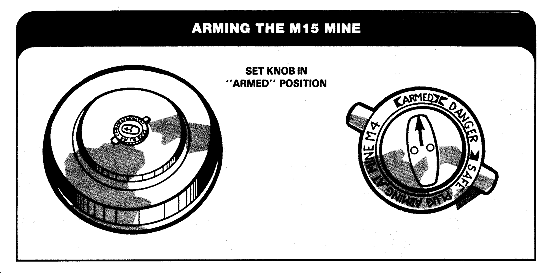
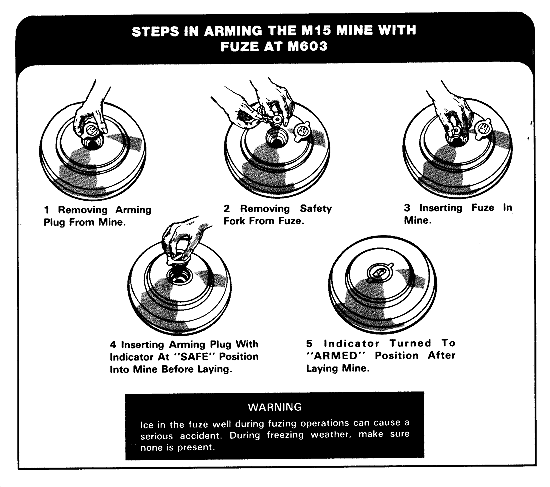
To disarm and remove an M15 mine, reverse the steps used to arm and install
it.
-
Carefully remove all camouflage from around the mine. Look for boobytraps
and other signs of tampering. If there are signs of tampering or boobytraps,
destroy the mine in place.
-
If there are no signs of tampering or boobytraps, Slowly turn the setting
knob from ARMED through DANGER to SAFE. Use the M20 wrench.
-
Turn the arming plug counterclockwise with the M20 wrench and remove it
from the mine.
-
Remove the fuze from the fuze well.
-
Insert the safety fork under the pressure plate and place the fuze in a
secure container.
-
Put the arming plug in the fuze well.
-
Remove the mine from the hole and put it in the packing box.
M21, ANTITANK MINE
This antitank mine has a cylindrical steel body. It is pressure detonated. A
pressure of 1.7 kg (3.75 lb) against the tilt rod (causing the rod to tilt 20
degrees or more) will detonate the mine. When not using the tilt rod, a pressure
of 131.5 kg (290 lb) on the pressure ring will detonate the mine.
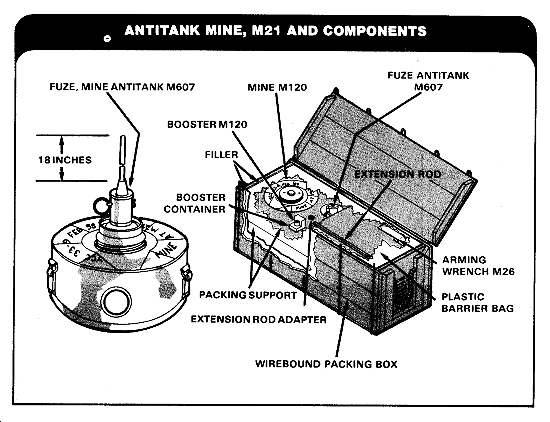
To emplace an M21 mine:
-
Remove the mine and its components from the packing box.
-
Inspect the mine and components for serviceability. Check for cracks,
dents, or other signs of damage. If a damaged item is found, replace it.
-
Make sure that the cotter pins of the fuze pull-ring assembly and the fuze
closure assembly are in place and secure.
-
Turn the mine bottom up and, with the screwdriver end of the M26 wrench,
remove the closing plug assembly by turning it counterclockwise.
-
Inspect the booster cavity for foreign matter. Remove any found.
-
Insert the M120 booster (with the washer side toward the fuze) into the
booster cavity.
-
With the M26 wrench, replace the closing-plug assembly by turning it
clockwise until tight. The gasket of the closing-plug assembly should be
against the booster.
-
Turn the mine bottom down.
-
With the M26 wrench, remove the shipping-plug assembly from the fuze hole
of the mine.
-
Inspect the fuze hole. If foreign matter is present, remove it from the
hole.
-
With the closure end of the M26 wrench, remove the closure assembly from
the M607 fuze. The gasket on the bottom of the fuze should stay in place.
-
Screw the fuze hand-tight into the threaded fuze hole of the mine charge
cap. Set the mine down.
-
Dig a hole in the ground 30 cm (12 in) in diameter and 15 cm (6 in) deep.
-
Check the bottom of the hole to make sure that the ground is solid and has
a firm, flat foundation for the mine to rest on. If the ground is soft, the
mine may tilt and lose effectiveness.
-
In soft ground, place a board or other flat object under the mine as a
firm foundation.
-
Place the mine in the hole.
-
Press the ground firmly against the sides of the mine, leaving the fuze
uncovered.
-
Screw the extension rod into the threaded pressure ring of the fuze.
-
Make sure that the extension rod is vertical.
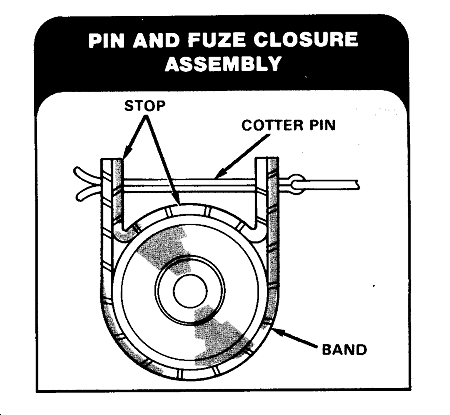

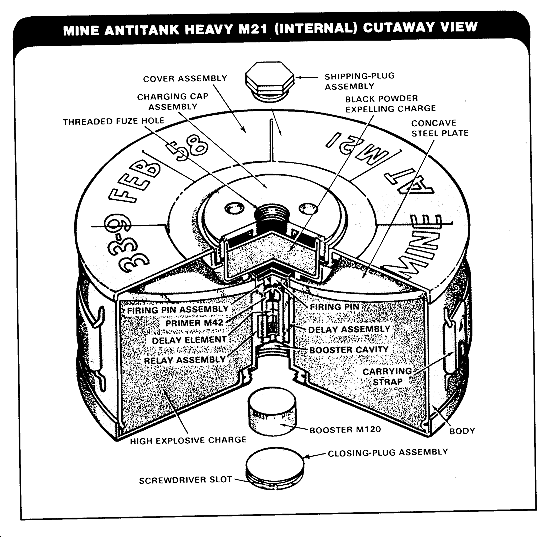

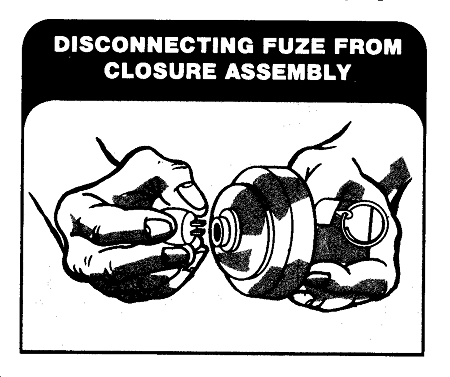
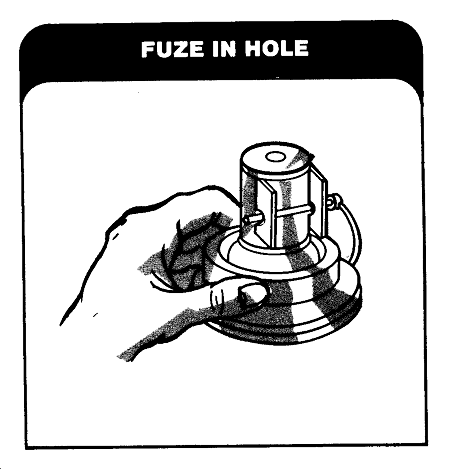
If the mine is being set for pressure detonation with the pressure rings, do
not use the extension rod. Instead:
-
Remove the pull ring assembly band and stop on the fuze. This arms the
mine.
-
Keep the above items for future use, if needed, to disarm the fuze.
-
Camouflage the mine.
To disarm and remove an M21 mine, reverse the steps used to arm and install
it.
-
Check the area for boobytraps or any signs of tampering. If there are
boobytraps or signs of tampering, destroy the mine in place.
-
If there are no boobytraps or signs of tampering, remove the camouflage
material from around the mine.
-
Reassemble the band, stop, and pull-ring assembly on the fuze so that the
pressure ring is immobilized. When the cotter pin is in place, spread the ends
so that it is not easily removable.
-
Remove the extension rod and the extension-rod adapter, if present. Be
careful not to damage them.
-
Remove the dirt from around the mine and remove the mine from the hole.
-
Remove the fuze from the mine and in-stall the closure assembly on the
fuze.
-
Install the shipping-plug assembly into the fuze hole of the mine.
-
Turn the mine bottom up and remove the closing-plug assembly.
-
Remove the booster, then reinstall the closing-plug assembly with the
gasket toward the booster cavity.
-
Put the mine, fuze, and components in their original container.
M24, OFF-ROUTE ANTITANK MINE
This is a remotely detonated mine system. It is activated by vehicles running
over a linear switch (called a discriminator) which causes a 3.5-inch HEAT (HIGH
EXPLOSIVE ANTI-TANK) rocket to be launched from an "off-route" launch position.
The launcher should be between 3 and 30 meters (10 to 100 feet) from the edge of
the path.
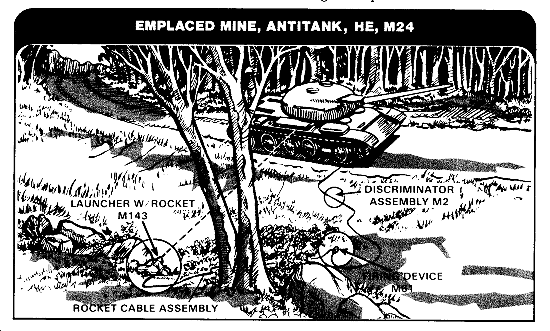

|
|
Approved for public release;
Distribution is unlimited.
The listing of any non-Federal product in this CD is not an endorsement of the
product itself, but simply an acknowledgement of the source.
Bureau of Medicine and Surgery
Department of the Navy
2300 E Street NW
Washington, D.C
20372-5300 |
Operational Medicine
Health Care in Military Settings
CAPT Michael John Hughey, MC, USNR
NAVMED P-5139
January 1, 2001 |
United States Special Operations
Command
7701 Tampa Point Blvd.
MacDill AFB, Florida
33621-5323 |
*This web version is provided by
The Brookside Associates Medical Education Division. It contains
original contents from the official US Navy NAVMED P-5139, but has been
reformatted for web access and includes advertising and links that were not
present in the original version. This web version has not been approved by the
Department of the Navy or the Department of Defense. The presence of any
advertising on these pages does not constitute an endorsement of that product or
service by either the US Department of Defense or the Brookside Associates. The
Brookside Associates is a private organization, not affiliated with the United
States Department of Defense.
Contact Us · · Other
Brookside Products

|
|
Operational Medicine 2001
Contents
|

|













































